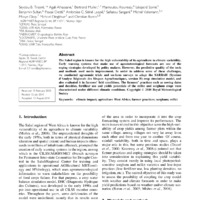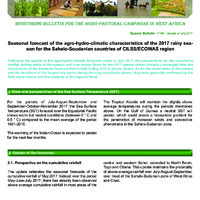Recherche
3 items
Characterizing and modeling the diversity of cropping situations under climatic constraints in west africa
The Sahel region is known for the high vulnerability of its agriculture to climate variability. Early warning systems that make use of agrometerological forecasts are one of the coping strategies developed by policy makers. However, the predictive quality of the tools and methods used needs improvement. In order to address some of these challenges, we conducted agronomic trials and on-farm surveys to adapt the SARRAH (Syst`eme d’Analyse R´egionale des Risques Agroclimatiques, version H) crop simulation model, and also evaluated it in farmers’ field conditions. The farmers’ practices such as sowing dates and densities, fertilizer use and yields potentials of the millet and sorghum crops were characterized under different climatic conditions.
Expanding capacity for translating seasonal climate forecasts into actionable information for agriculture and water sectors in West Africa: Lessons learnt and way forward
With climate change and variability posing challenges to sub-Saharan Africa’s development sectors, weather and climate information services are crucial for building climate-resilient development pathways (Hansen et al., 2022). Seasonal forecasts in particular provide prospective information about the upcoming season, with a particular focus on precipitation and temperature (Guido et al., 2020; Hansen et al., 2011). However, a direct and linear translation of the seasonal forecasts to sector-specific information such as water resources and agriculture can lead to inaccurate recommendations. Integrating seasonal forecast data into biophysical models can enable the generation of sector-relevant actionable information that can improve the decision-making (Hansen, 2005; Houngnibo et al 2023). This would contribute to a better understanding of the impacts of climate forecasts in the water and agriculture sectors, among others, thereby facilitating more informed decision-making.
Regional operational meteorological centers, including AGRHYMET Regional Climate Center for West Africa and the Sahel (AGRHYMET CCR-AOS), are regularly producing seasonal climate forecasts to help inform adaptation decision-making at various levels. As a Regional Climate Center, AGRHYMET CCR-AOS coordinates the development of consensus seasonal forecasts through Regional Climate Outlook Forums (RCOF), which bring together experts from National Meteorological and Hydrological Services (NMHSs), basin organizations, and global climate centers. AGRHYMET CCR-AOS has proposed a new approach to translate seasonal forecasts into sector-specific actionable information for agriculture and water sectors through crop and hydrological models. This is referred to as extended seasonal forecasts in agriculture and water sectors (Houngnibo et al 2023).
As part of AICCRA West Africa cluster activities, AGRHYMET has capacitated NMHSs in West Africa and the Sahel on this approach as a first step towards extended and widespread uptake and utilisation in NMHSs in the region. The capacity building event took place in Ouagadougou, Burkina-Faso from August 7th to 11th, 2023. The objective was to enhance the capacity of NMHSs to use new tools that combine seasonal forecasts with impact models in the agriculture and water resources sectors. This Info Note documents the process, key insights and lessons from the regional capacity building for translating seasonal forecasts into actionable information for agriculture and water sectors in West Africa for a better-informed policy and action decision making.
Seasonal forecast of the agro-hydro-climatic characteristics of the 2017 rainy season for the Sahelo-Soudano countries of CILSS/ECOWAS region
Following the update of the agro-hydro-climatic forecasts made in July 2017, the perspectives for the cumulative rainfall, ending dates of the season and river basins flows for the 2017 season remain broadly unchanged from the conclusions of the Seasonal Forecast Forum held in May 2017 in Accra, Ghana. As for the onset dates of the season and the durations of the longest dry spells during the crop installation phase, they were generally confirmed by the field observations and the analyses at the regional level.


